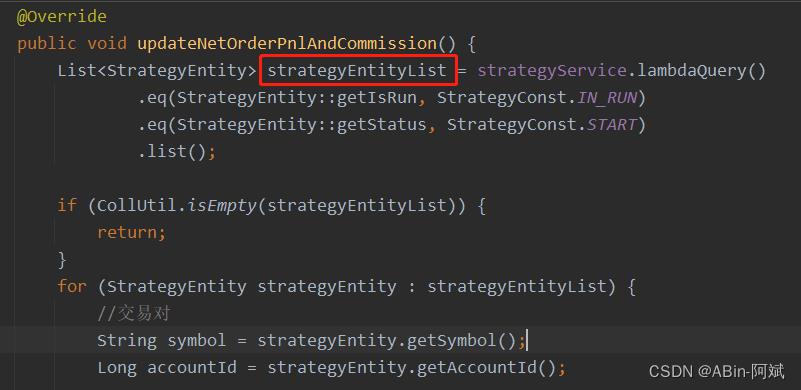接口查询优化:优雅的处理大批量数据及 in 超过 1000 问题
Posted ABin-阿斌
tags:
篇首语:本文由小常识网(cha138.com)小编为大家整理,主要介绍了接口查询优化:优雅的处理大批量数据及 in 超过 1000 问题相关的知识,希望对你有一定的参考价值。
我是 ABin-阿斌:写一生代码,创一世佳话,筑一览芳华。
如果小伙伴觉得不错就一键三连吧~
文章目录
一、问题点
- 有时候在查询数据时可能需要根据【A表】的某个 ID 去获取 【B表】 的具体信息,但是又因为数据量的庞大,我们需要对 【A表】查出来的数据结果进行分页处理之后再循环调用【B表】
二、解决方案
1、在业务层面用Java代码进行分页处理
- 比如:通过策略ID去获取当前策略下的订单信息,那么为了防止订单信息过多我们可以这么做

- 首先将查询获取订单信息在Service层写一个分页接口,然后进行调用
- 具体的分页参数信息可以根据业务来定,这里进行分批处理,一页:100条
- 然后进行循环翻页处理



2、使用工具类 List 总数切分
-
注意: ListUtil.partition(),这个方法从某种意义上说并没有达到真正分页的效果,因为当我们使用这个方法时,List结果早已执行出来了;我们要做的就是在结果没有出来之前就减少 DB 的压力。
-
当然,具体业务具体分析,少量的数据可以使用这个方法
-
直接使用 Hutool 工具类中的 ListUtil.partition(list,100)方法,参数一: 具体 list、参数二: 具体分多少条
3、自己封装一个分页工具类
- 下面这个工具类适用于 MyBatisPlus
工具类代码
public class MybatisParameterUtils
public static <T, F> void cutInParameter(LambdaQueryWrapper<T> wrapper, SFunction<T, ?> column, List<F> coll) throws Exception
List<List<F>> newList = splitList(coll, 900);
if (ObjectUtils.isEmpty(newList))
throw new Exception("参数错误");
else if (newList.size() == 1)
wrapper.in(column, newList.get(0));
return;
wrapper.and(i ->
i.in(column, newList.get(0));
newList.remove(0);
for (List<F> objects : newList)
i.or().in(column, objects);
);
public static <T, F> void cutNotInParameter(LambdaQueryWrapper<T> wrapper, SFunction<T, ?> column, List<F> coll) throws Exception
List<List<F>> newList = splitList(coll, 900);
if (ObjectUtils.isEmpty(newList))
throw new Exception("参数错误");
else if (newList.size() == 1)
wrapper.notIn(column, newList.get(0));
return;
wrapper.and(i ->
i.in(column, newList.get(0));
newList.remove(0);
for (List<F> objects : newList)
i.or().notIn(column, objects);
);
public static <T, F> void cutInParameter(LambdaQueryChainWrapper<T> wrapper, SFunction<T, ?> column, List<F> coll) throws Exception
List<List<F>> newList = splitList(coll, 900);
if (ObjectUtils.isEmpty(newList))
throw new Exception("参数错误");
else if (newList.size() == 1)
wrapper.in(column, newList.get(0));
return;
wrapper.and(i ->
i.in(column, newList.get(0));
newList.remove(0);
for (List<F> objects : newList)
i.or().in(column, objects);
);
public static <T, F> void cutNotInParameter(LambdaQueryChainWrapper<T> wrapper, SFunction<T, ?> column, List<F> coll) throws Exception
List<List<F>> newList = splitList(coll, 900);
if (ObjectUtils.isEmpty(newList))
throw new Exception("参数错误");
else if (newList.size() == 1)
wrapper.notIn(column, newList.get(0));
return;
wrapper.and(i ->
i.in(column, newList.get(0));
newList.remove(0);
for (List<F> objects : newList)
i.or().notIn(column, objects);
);
public static <T, F> void cutInParameter(LambdaUpdateWrapper<T> wrapper, SFunction<T, ?> column, List<F> coll) throws Exception
List<List<F>> newList = splitList(coll, 900);
if (ObjectUtils.isEmpty(newList))
throw new Exception("参数错误");
else if (newList.size() == 1)
wrapper.in(column, newList.get(0));
return;
wrapper.and(i ->
i.in(column, newList.get(0));
newList.remove(0);
for (List<F> objects : newList)
i.or().in(column, objects);
);
public static <T, F> void cutNotInParameter(LambdaUpdateWrapper<T> wrapper, SFunction<T, ?> column, List<F> coll) throws Exception
List<List<F>> newList = splitList(coll, 900);
if (ObjectUtils.isEmpty(newList))
throw new Exception("参数错误");
else if (newList.size() == 1)
wrapper.notIn(column, newList.get(0));
return;
wrapper.and(i ->
i.in(column, newList.get(0));
newList.remove(0);
for (List<F> objects : newList)
i.or().notIn(column, objects);
);
public static <T, F> void cutInParameter(LambdaUpdateChainWrapper<T> wrapper, SFunction<T, ?> column, List<F> coll) throws Exception
List<List<F>> newList = splitList(coll, 900);
if (ObjectUtils.isEmpty(newList))
throw new Exception("参数错误");
else if (newList.size() == 1)
wrapper.in(column, newList.get(0));
return;
wrapper.and(i ->
i.in(column, newList.get(0));
newList.remove(0);
for (List<F> objects : newList)
i.or().in(column, objects);
);
public static <T, F> void cutNotInParameter(LambdaUpdateChainWrapper<T> wrapper, SFunction<T, ?> column, List<F> coll) throws Exception
List<List<F>> newList = splitList(coll, 900);
if (ObjectUtils.isEmpty(newList))
throw new Exception("参数错误");
else if (newList.size() == 1)
wrapper.notIn(column, newList.get(0));
return;
wrapper.and(i ->
i.in(column, newList.get(0));
newList.remove(0);
for (List<F> objects : newList)
i.or().notIn(column, objects);
);
public static <F> List<List<F>> splitList(List<F> list, int groupSize)
int length = list.size();
// 计算可以分成多少组
int num = (length + groupSize - 1) / groupSize;
List<List<F>> newList = new ArrayList<>(num);
for (int i = 0; i < num; i++)
// 开始位置
int fromIndex = i * groupSize;
// 结束位置
int toIndex = Math.min((i + 1) * groupSize, length);
newList.add(list.subList(fromIndex, toIndex));
return newList;
案例展示
- 思路就是把条件拆成小于 1000 的组合条件 写 xml 同理
// 这是一个条件wrapper get方法的方法引用 一个参数list
MybatisParameterUtils.cutInParameter(deleteInfoWrapper, Vo::getId, list);
- 要带进去 In 的参数,这个参数有数量可能会很大

- 参数一:wrapper;参数二:要 in 那个的参数;参数三:具体带进去 in 的参数(list)

4、适用于Mybatis SQL写法
<if test="dto.idList != null and dto.idList.size() > 0">
and (t.id IN
<foreach collection="dto.idList" index="index" open="(" close=")" item="item" >
<if test="index !=0">
<choose>
<when test="index % 1000 == 999">) OR t.id IN (</when>
<otherwise>,</otherwise>
</choose>
</if>
#item
</foreach>
)
</if>
以上是关于接口查询优化:优雅的处理大批量数据及 in 超过 1000 问题的主要内容,如果未能解决你的问题,请参考以下文章
